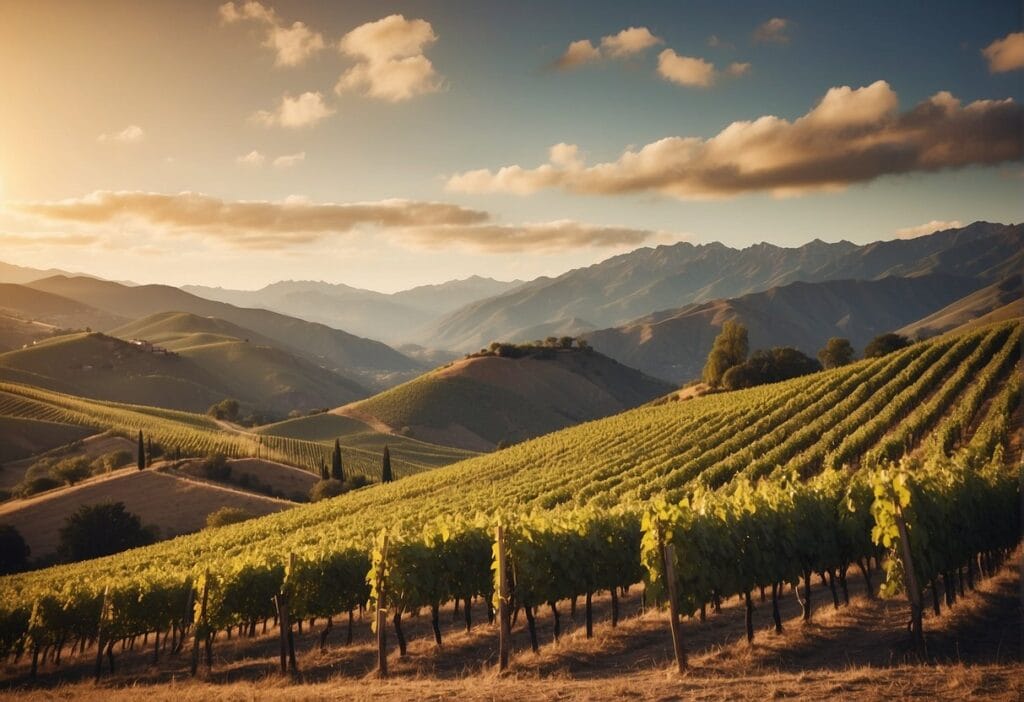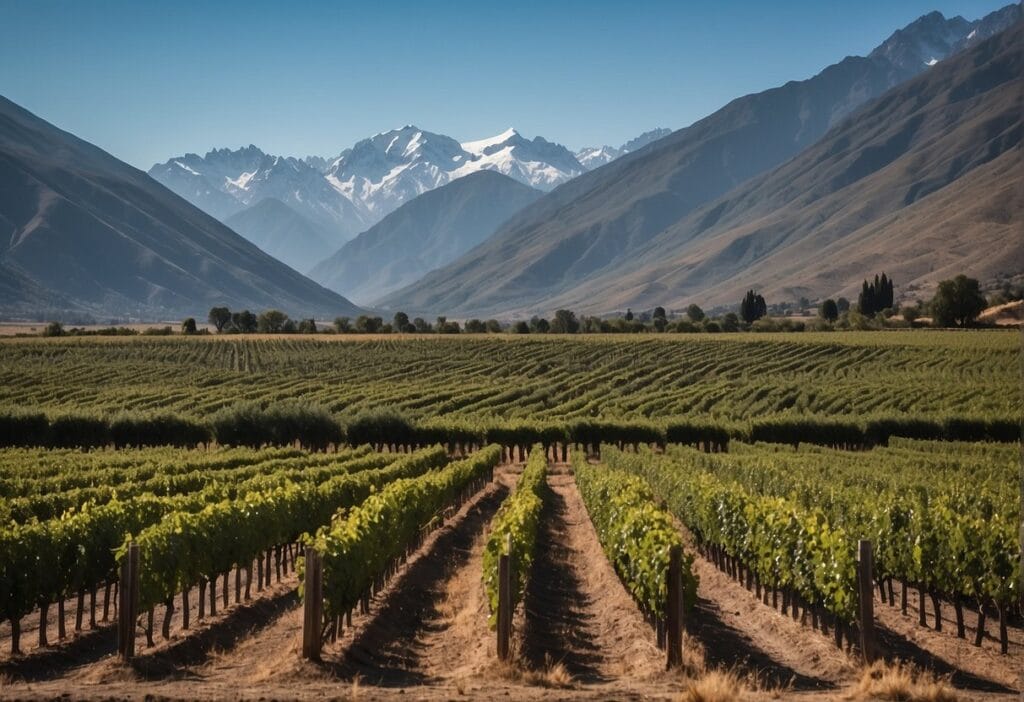Australia’s reputation as a top wine-producing country is rooted in the rich tapestry of its wine regions. Each region offers a distinct taste of its landscape.
As you explore these regions, you’ll find that the varied climates and soils give rise to unique expressions of classic grape varieties. For example, the sun-drenched vineyards of South Australia produce robust Shiraz. Meanwhile, the cooler, maritime climes of Tasmania are home to elegant sparkling wines.

Australian wine-making is deeply influenced by the location. This geographical diversity forms the backbone of its wine industry.
As you delve into the world of Australian wines, you’ll notice the legacy of winemaking tradition intertwined with innovation. This combination has propelled Australia onto the global stage. Today, Australia’s emphasis on quality and character rivals the old wine regions of Europe.
Your journey might take you from the established vineyards of Victoria, with their celebrated Pinot Noir, to the up-and-coming estates in Queensland. Each sip offers a glimpse into the harmony between the Australian landscape and the artistry of winemaking.
Key Takeaways
- Australia boasts a diverse array of wine regions, each known for different grape varieties and wine styles.
- The culture of winemaking in Australia marries tradition with innovation, reflected in high-quality wines with unique character.
- Exploring Australian wines provides insight into how regional climates and winemaking techniques influence the final product.
History and Evolution of Australian Wine Regions
Australian wine regions boast a rich tapestry combining history and innovation. The journey began in the early 19th century with figures such as John Macarthur, who pioneered the industry, establishing Australia’s first commercial vineyard.
Over time, the industry expanded, initially focusing on fortified wines. But by 1995, a significant shift saw 94% of grapes being used for table wine. This marked an evolution in palate and production techniques that aligned with international trends.
Wine production has always been deeply intertwined with the varied terroir across the continent. Regions such as Barossa Valley and Clare Valley are renowned for their rich soils and ideal climate, fostering the growth of premium Shiraz and Riesling.
In the mid-20th century, Australian wine saw a period of decline in exports. However, this set the stage for a revolutionary shift in the subsequent decades. A newfound focus on quality and regional characteristics led to an explosion in popularity abroad.
Your appreciation of Australian wine wouldn’t be complete without acknowledging the influence of Aboriginal practices. Traditional land care methods have indirectly influenced viticultural practices, contributing to the sustainability and character of the wine regions.
Contemporary Australian winemakers continue to balance traditional methods with innovative techniques. This ensures the country’s wine regions mature like a fine wine themselves.
Overview of Australian Wine Regions
Australian wine regions boast a diverse range of climates and soils, leading to equally diverse wine varieties. You’ll find over 60 designated wine regions across the country, each with its unique character and style.
- Barossa Valley: Famed for robust Shiraz, this warm region near Adelaide offers some of the world’s most notable wines.
- McLaren Vale: Also near Adelaide, McLaren Vale is versatile, producing excellent Shiraz, Grenache, and Cabernet.
- Adelaide Hills: Known for elegant, crisp whites, including Chardonnay and Sauvignon Blanc, as well as cool climate Shiraz.
For lovers of Cabernet Sauvignon, the Coonawarra region’s terra rossa soil is legendary. High altitude and cooler climate areas like the Eden Valley and Clare Valley are revered for Riesling.
Venture into Victoria to explore a myriad of wine experiences:
- Yarra Valley: Cool climate suits Chardonnay, sparkling wine, and Pinot Noir.
- Mornington Peninsula & Macedon Ranges: You’ll enjoy exquisite Pinot Noir and Chardonnay.
- Rutherglen: Indulge in fortified wines, including world-renowned Muscats.
New South Wales presents the Hunter Valley, known for its age-worthy Semillon, while Orange and Mudgee are rising stars.
In the country’s southwest corner, the Margaret River region produces outstanding Cabernet Sauvignon and Chardonnay that you’ll treasure.
For a cooler climate experience:
- Tasmania offers exceptional sparkling wines and Pinot Noir.
- Canberra District’s Shiraz and Riesling are gaining acclaim.
View Australia’s full-bodied reds in a new light at the Swan Valley, a short drive from Perth. Moreover, Queensland’s Granite Belt is making a mark with its high-altitude vineyards. For expansive vine-growing areas, Riverland and Murray Darling have your interest at heart.
South Australia
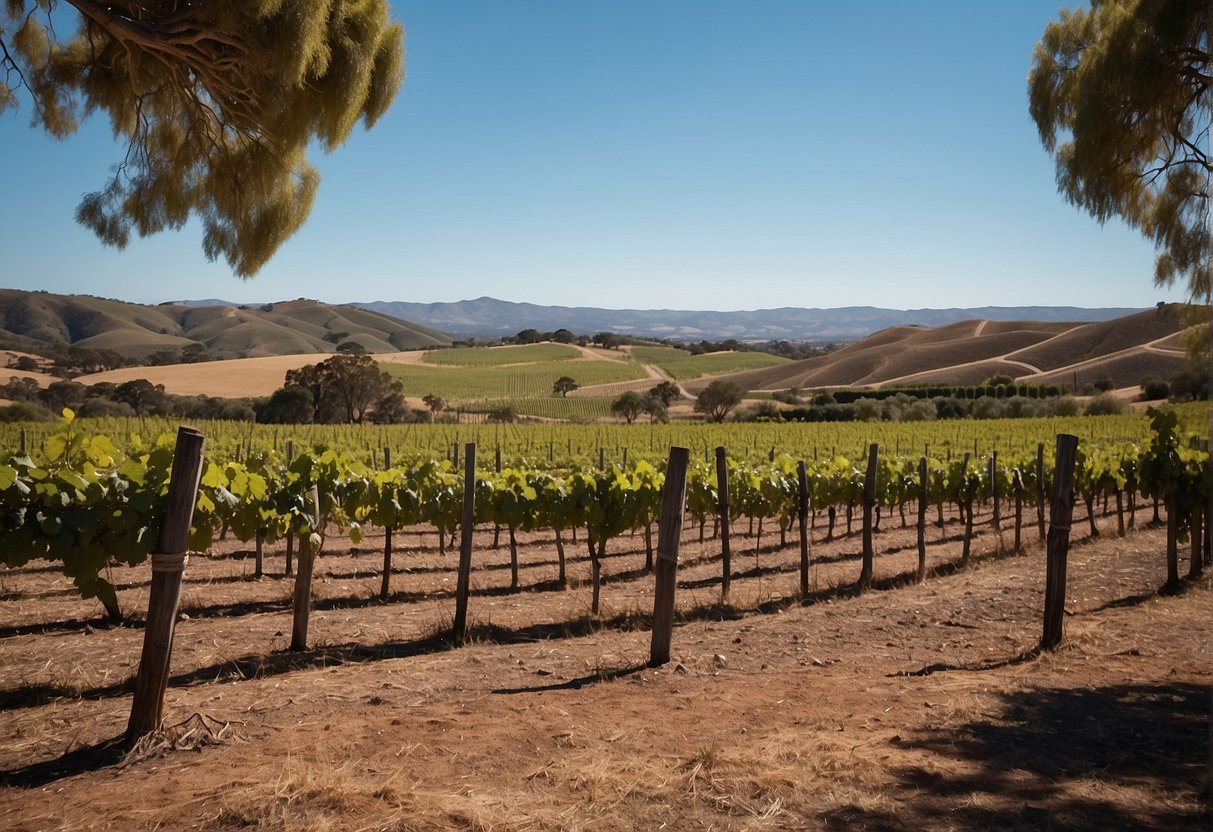
South Australia is renowned for its diverse and exceptional wine regions, each offering a unique experience for your palate. As you explore, you’ll encounter the Barossa Valley, under an hour from Adelaide, where you can taste world-famous, full-flavoured Shiraz, Grenache, and Cabernet Sauvignon (The ultimate guide to South Australia’s wine regions).
Venture into the McLaren Vale, celebrated for its innovation in wine production and sustainable practices, with Mediterranean-style wines on offer. Coonawarra is another gem, distinguished by its legendary terra rossa soil that nourishes vines and results in exceptional Cabernet Sauvignon.
- Barossa Valley: Historic vineyards; robust reds.
- McLaren Vale: Sustainable wines; Mediterranean influence.
- Coonawarra: ‘Terra rossa’ soil; premium Cabernet Sauvignon.
In the cool climate of Eden Valley, you’ll enjoy elegantly structured Rieslings. Meanwhile, the Adelaide Hills region offers a refreshing escape with its crisp whites and cool climate reds. The Clare Valley is your go-to for exquisite Rieslings; its picturesque setting only enhances the tasting experience.
| Region | Varietal Specialties |
|---|---|
| Barossa Valley | Shiraz, Grenache, Cabernet |
| McLaren Vale | Shiraz, Chardonnay, Grenache |
| Coonawarra | Cabernet Sauvignon |
| Eden Valley | Riesling |
| Adelaide Hills | Sauvignon Blanc, Pinot Noir |
| Clare Valley | Riesling |
Victoria
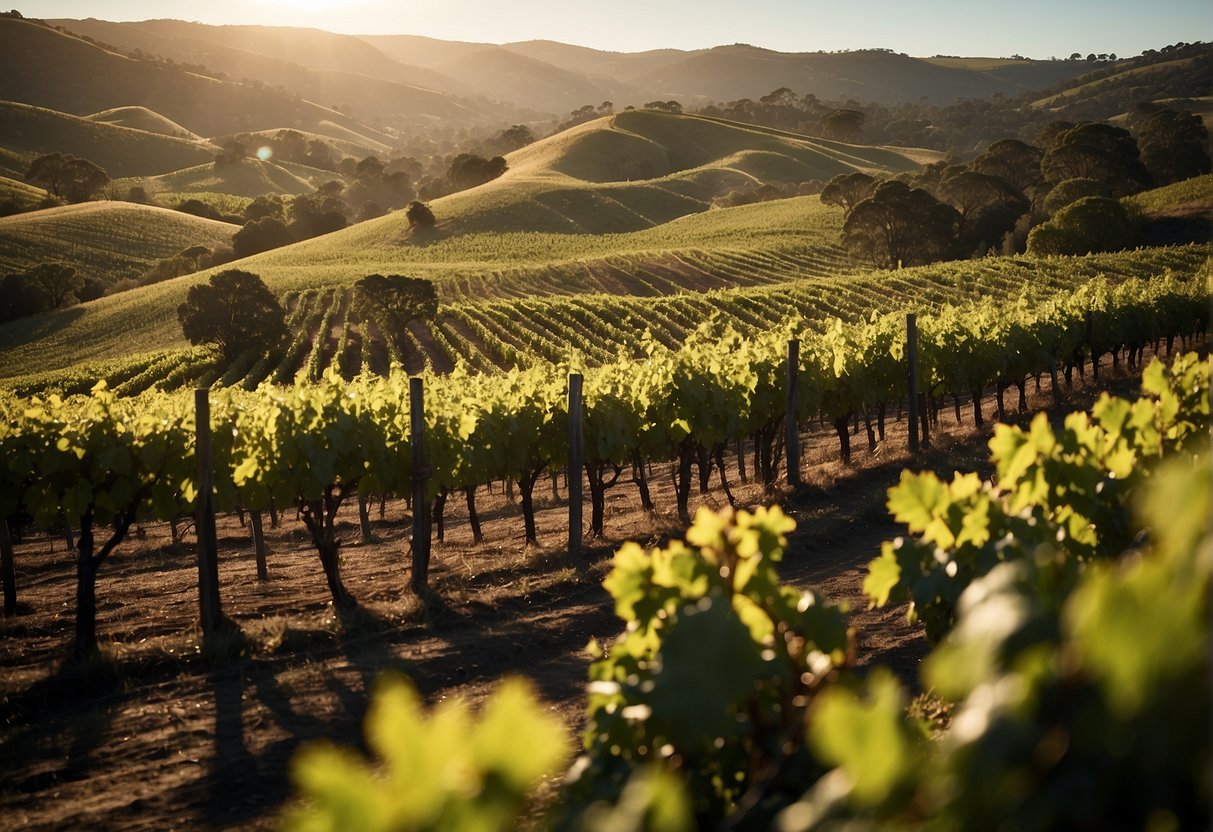
When you explore the wine regions of Australia, Victoria offers a remarkable diversity with its cool, moderate, and hot climates. This array of climates allows for the production of a wide variety of wine styles.
Yarra Valley, less than an hour’s drive from Melbourne, is a jewel in Victoria’s winemaking crown. Here, you’ll find a mix of traditional and contemporary wineries focused on producing high-quality Pinot Noir and Chardonnay. Beyond these, they also craft exceptional Cabernet Sauvignon and Shiraz.
Venturing to the Mornington Peninsula, you’ll discover a cool maritime climate that’s perfect for elegant Pinot Noir and Chardonnay wines. The wineries here leverage the sea breezes to create delicate wines that are both complex and balanced.
Rutherglen is iconic, especially for its fortified wines. The region’s warm climate leads to the production of luscious, rich Muscats and Topaques that truly stand out.
For an elevated experience, Macedon Ranges’ high-altitude vineyards make for some of the coolest climate conditions in mainland Australia. This results in superb sparkling wines and finely structured still wines.
Heading west, the Grampians is known for its powerful and peppery Shiraz, benefiting from a long and rich winemaking history. Similarly, the Pyrenees region combines natural beauty with boutique wineries, where Cabernet Sauvignon and Shiraz vines thrive in the shelter of the Blue Pyrenees Range.
In NE Victoria, you’ll find wine sub-regions like King Valley and Alpine Valleys, which present an exciting range of Italian and other alternative varietals due to their unique terroirs.
New South Wales
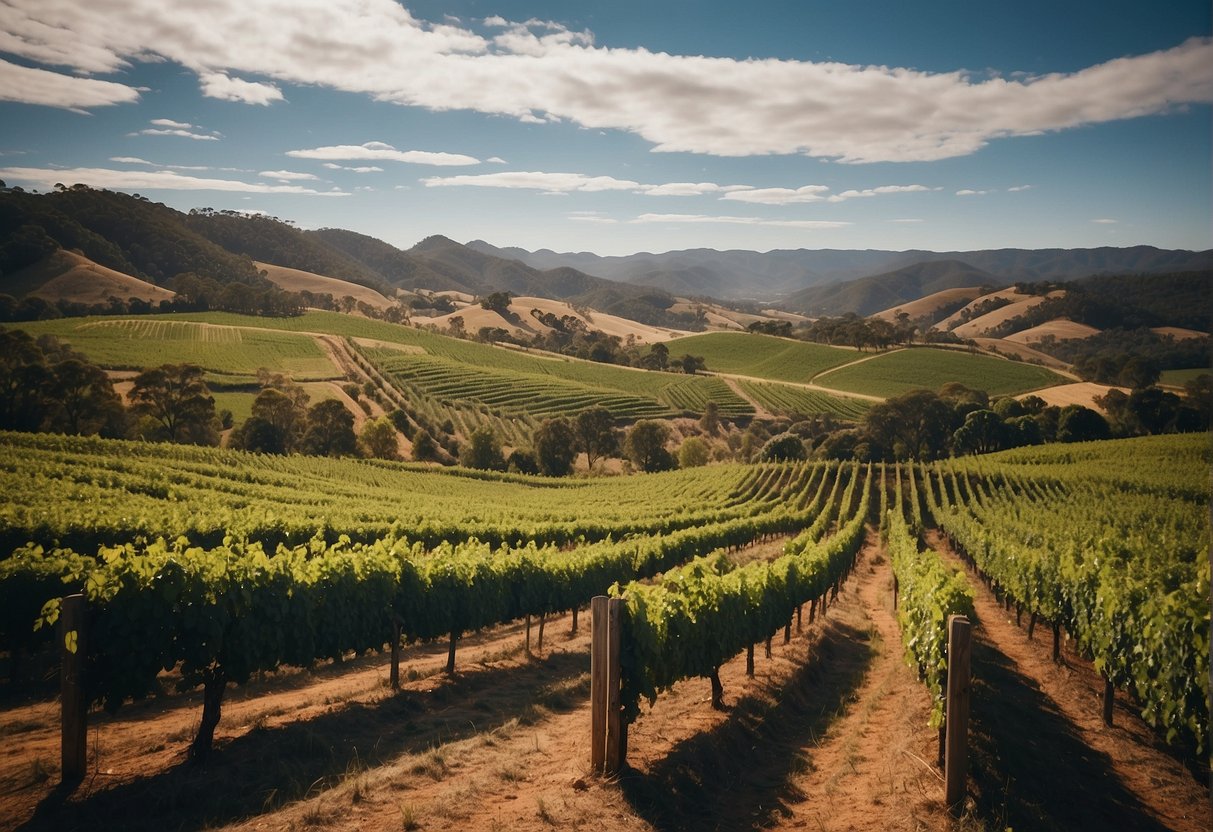
When you explore New South Wales (NSW), you’ll discover a treasure trove of wine experiences. This vibrant region offers a wide variety of climates and terrains, producing an exciting array of wines.
Hunter Valley: Renowned for its Semillon and Shiraz, Hunter Valley is not only the oldest wine region in NSW but also one of Australia’s most famous wine destinations. You’ll enjoy the heritage and taste profile of wines that have been refined over generations.
Orange: At an elevation over 600 meters, Orange is known for its cool climate and rich volcanic soils. These contribute to the elegant Chardonnays and Cabernet Sauvignons you’ll find here. The high altitude brings a crisp freshness to their wines.
Mudgee: With a winemaking history dating back to the 1850s, Mudgee’s high altitude and rich soils produce bold red wines. Experience the depth of Merlot and complexity of Cabernet Sauvignon from this area.
Riverina: This region is not only a major grape producer but also the site of the ‘Botrytis Semillon’, a lush, sweet dessert wine that you’ll surely adore. Riverina’s warm climate brings out the best in these grapes.
South Coast: Enjoy the coastal vibe while sipping on wines that carry a hint of oceanic freshness. The cool climate vines yield delicate flavors with a unique character, shaped by the proximity to the sea.
Canberra District: Just a stone’s throw from NSW, this area is emerging for its Riesling and Shiraz, sharing similar cool climate benefits. With each visit, you’ll taste the refinement in every glass.
Western Australia
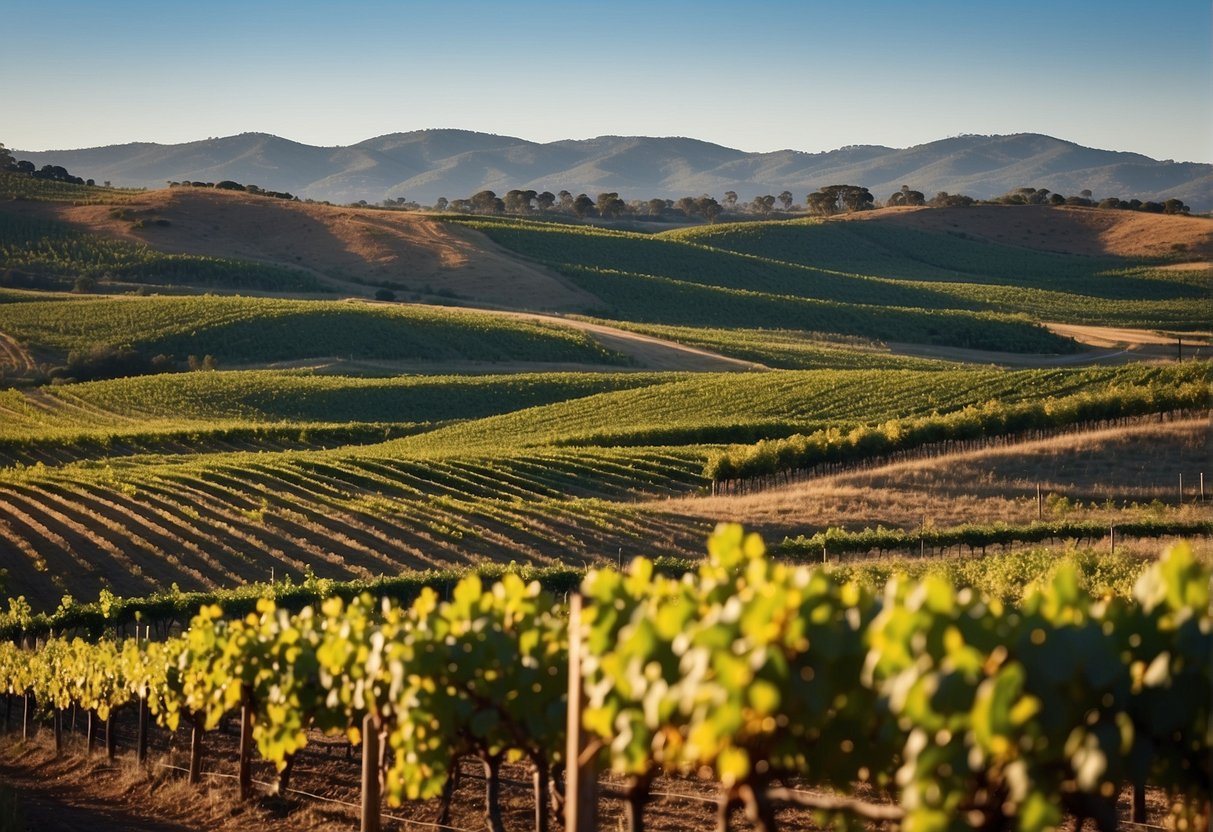
When you’re exploring the vast world of Australian wines, your journey isn’t complete without a visit to the exceptional Western Australia wine regions. Each area offers a distinct experience with a common thread of quality and stunning scenery.
Margaret River
One of your must-visit destinations is the Margaret River wine region. Renowned for its premium wines, Margaret River balances its wine prowess with breathtaking coastal views. You’ll find over 200 vineyards, passionately producing world-class Cabernet Sauvignon and Chardonnay. The maritime climate here is a key factor, thanks to the cooling breezes from the Indian Ocean.
Swan Valley
A short drive from Perth brings you to Swan Valley, Western Australia’s oldest wine region. It’s known for its warm, dry climate, which is ideal for producing rich, ripe reds and fortified wines. This region has a heritage woven into every glass, with many family-run wineries offering a personal touch to your tasting experience.
Perth Hills
In the Perth Hills, the cooler elevation provides a perfect setting for producing more delicate varieties. It’s a wine region that’s making a name for itself with its boutique vineyards and small-batch releases.
The Great Southern
Spanning five subregions, the Great Southern is a rising star. Here, cool climate varieties like Riesling and Pinot Noir thrive, enabling producers to craft wines of elegance and depth.
Tasmania
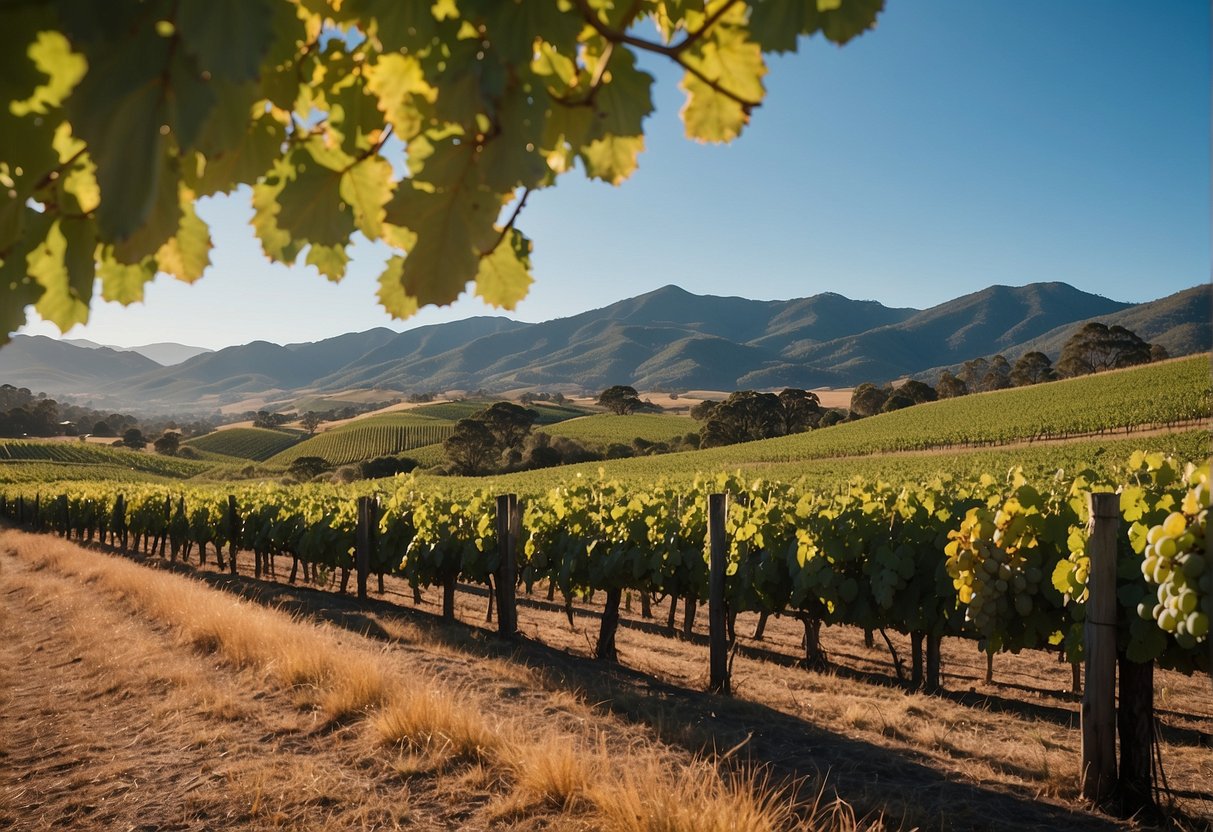
When you’re exploring Australian wines, Tasmania should be at the top of your list. Often referred to as the Apple Isle, this small island offers a unique cool-climate winemaking environment, contributing to the production of exceptional wines.
Hobart, Tasmania’s capital, serves as an excellent starting point for your wine adventures. Here, the Coal River Valley is a mere 15-minute drive from the city and provides an abundance of award-winning wineries.
As you navigate through Tasmania’s wine regions, you will discover various wineries that offer a personal touch to your tasting experience.
Tasmania is particularly known for its sparkling wines, which rival some of the world’s best. But let’s not stop there; the region also excels in producing top-notch Pinot Noir and Chardonnay. Due to its climate and terroir, Tasmanian wines often exhibit crisp acidity and complex aromatics.
Here’s a quick overview of what you’ll find:
- Sparkling Wines: Comparable to French Champagne.
- Pinot Noir: Rich and elegant, with great depth.
- Chardonnay: Bright and textured, often barrel-fermented.
Visit a local winery and you might also taste exceptional Riesling, Sauvignon Blanc, and the increasingly popular Pinot Gris. With over 200 vineyards throughout the island, you’re never too far from a delightful wine-tasting experience.
And don’t forget to pair your wine with some of Tasmania’s finest local produce; the gastronomic delights here truly complement the wines. So grab your glass and get ready to explore the wine regions of Tasmania; you’re in for a treat!
Queensland
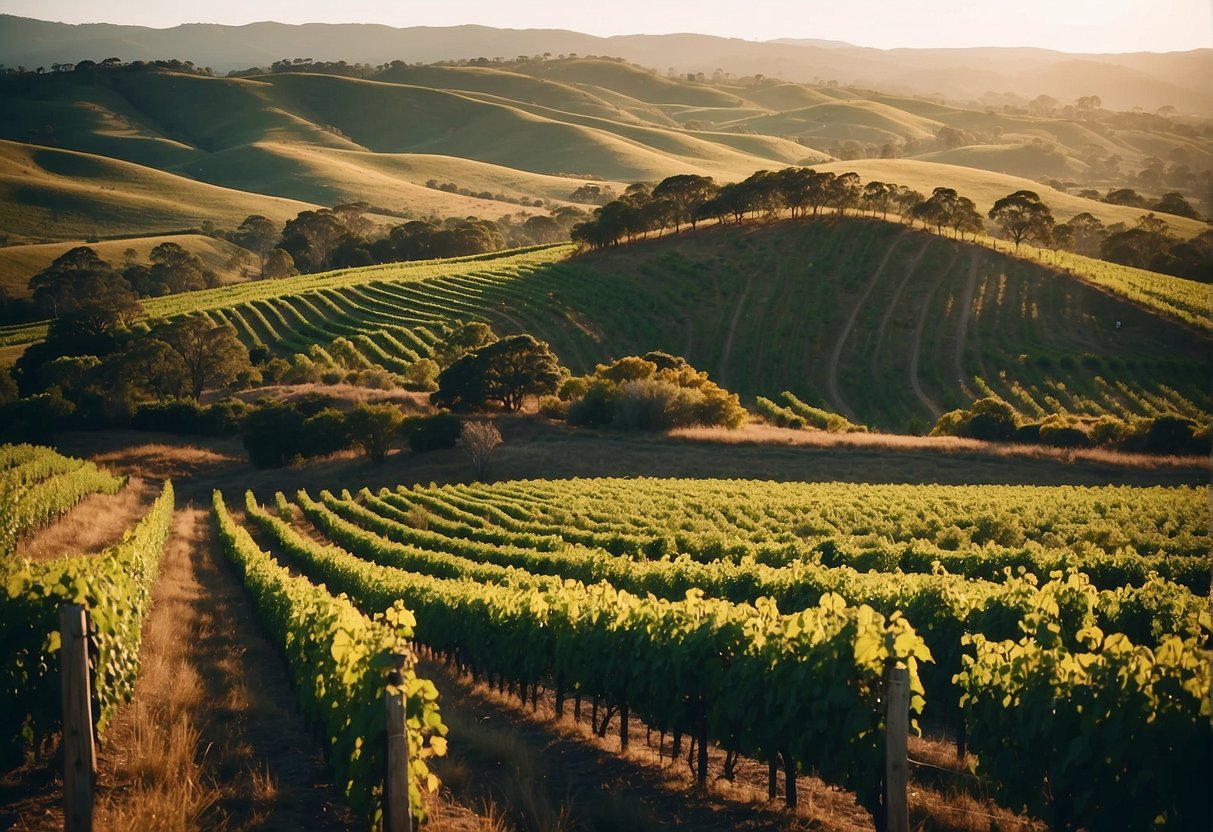
When you explore the wine regions of Australia, Queensland offers a delightful and diverse experience. With a warmer climate than its southern counterparts, Queensland is home to bold and innovative winemakers.
The Granite Belt stands out as the jewel in Queensland’s wine crown, famed for its unique terroir and high altitude. This area is revered for crafting distinctive wines, offering a robust selection of both red and white varieties. Delving into the Granite Belt, you’ll be charmed by its boutique wineries and the chance to experience the art of winemaking.
Recognised Regions:
- Granite Belt
- South Burnett
Popular Varietals:
- Chardonnay
- Shiraz
- Merlot
While navigating Queensland’s wine offerings, you won’t be limited to these varietals. You’ll find a canvas of flavors, from the crisp and refreshing whites to the rich and complex reds. Moreover, local wineries often feature a selection of unique blends and varietals that reflect the adventurous spirit of the region.
Wine Tourism is gaining momentum, and Queensland’s wineries are more than just a place to taste wine; they’re destinations. Enjoy the lush sceneries and a warm, inviting atmosphere as you sip on a glass of Queensland’s finest.
Other Regions
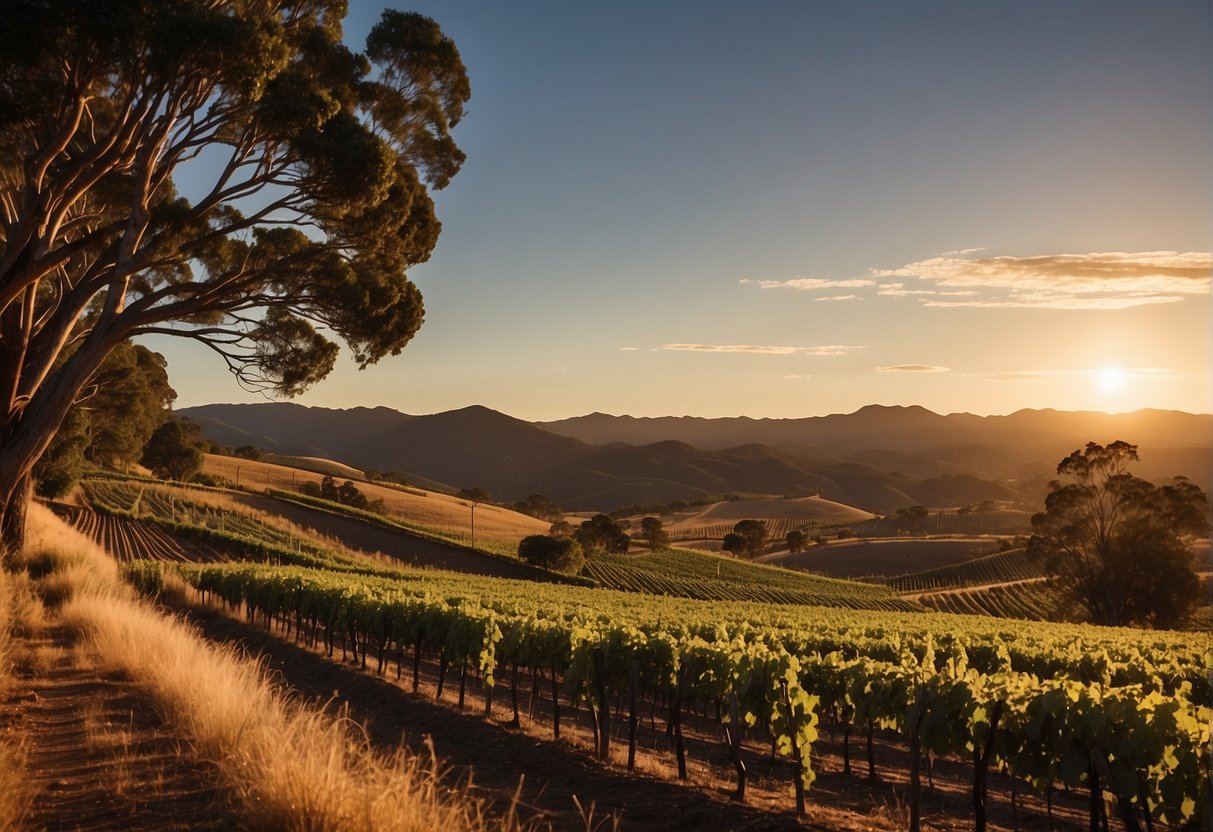
In your exploration of Australian wines, beyond the well-known areas like the Barossa Valley and Hunter Valley, you’ll find a wealth of diversity in lesser-publicized regions.
Murray Darling is one such area that merits your attention. Nestled on the border of New South Wales and Victoria, this region flourishes under the Australian sun, nurturing grapes that transform into vibrant and flavorful wines. It’s thriving with both large-scale operations and boutique wineries, ensuring a wide selection for your palate.
You might not be as familiar with names out of De Bortoli, but here’s why you should be: De Bortoli Wines, a family-operated venture founded in 1928, has gained a reputation for producing premium wines. From their plantings in regions including Riverina and Yarra Valley, you can expect remarkable wines that truly reflect the terroir.
- Noteworthy Varieties:
- Riverina: Famous for its Botrytis Semillon, a sweet dessert wine with international acclaim.
- Yarra Valley: Shines with cool climate classics like Chardonnay and Pinot Noir.
Your journey might lead you to other under-the-radar wine regions such as Tasmania, known for exceptional sparkling wines and crisp Chardonnays, or Margaret River in Western Australia, where Cabernet Sauvignon and Chardonnay varieties enjoy a global following.
Key Australian Grape Varieties
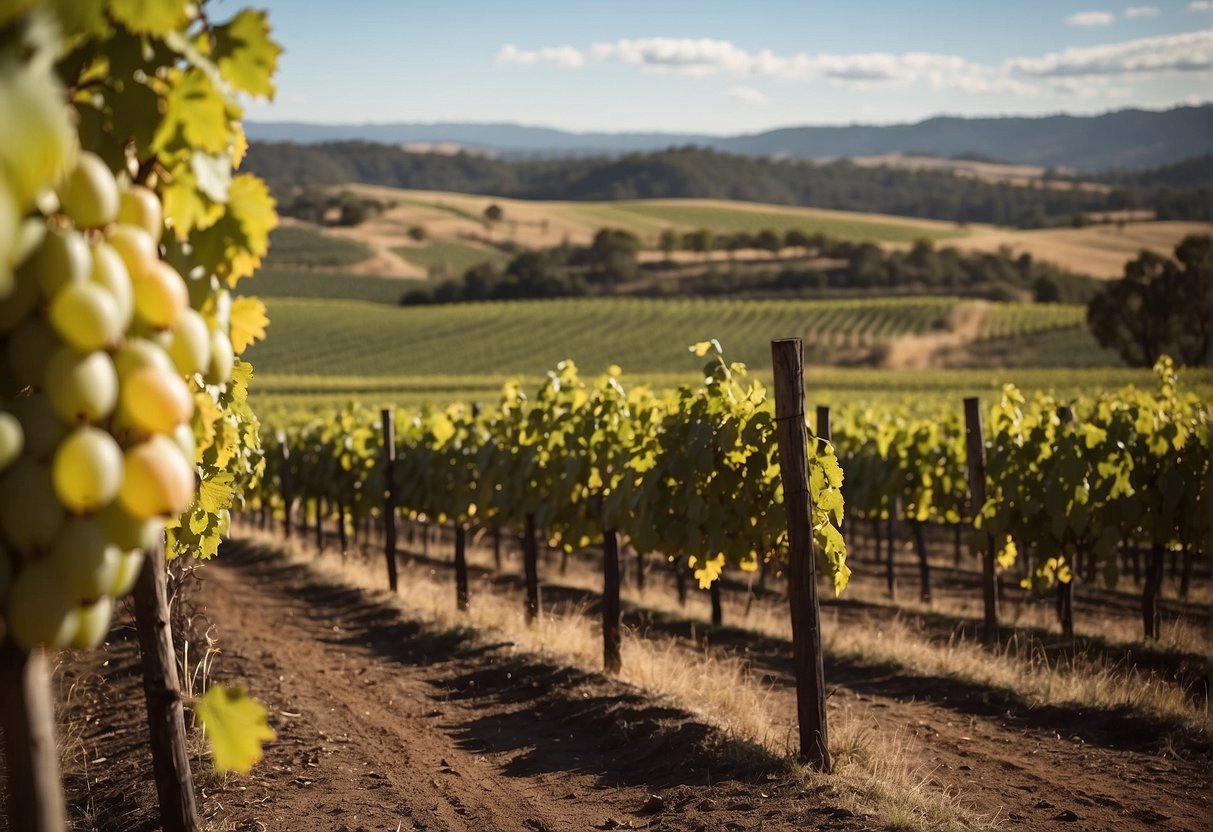
In your exploration of Australian wines, you’ll discover a diverse array of grape varieties. Each variety contributes its unique characteristics to the wine it produces.
Shiraz: Also known as Syrah, this grape is a cornerstone of Australian viticulture. As Australia’s most planted variety, Shiraz gives you wines with robust flavors, often with a signature peppery note.
Chardonnay: You’ll find that Chardonnay is versatile and widely planted. Australian Chardonnay ranges from rich and creamy to crisp and citrusy.
Cabernet Sauvignon: Bold and assertive, Cabernet Sauvignon from Australia presents you with a rich palette of flavors, including dark berries and savory notes.
Pinot Noir: This grape might be tricky to grow, but Australian Pinot Noir rewards you with its delicate, nuanced flavors that can range from cherries to earthy undertones.
Sauvignon Blanc: Enjoy the zesty and refreshing qualities of Sauvignon Blanc. It’s typically vibrant with high acidity and tropical fruit flavors.
Riesling: Australian Riesling, especially from regions like Clare and Eden Valley, tends to be crisp, with a characteristic lime note and often a minerally finish.
| Variety | Profile Note |
|---|---|
| Grenache | Berry flavors with a spicy touch. |
| Semillon | Often aged to reveal complex notes. |
| Mourvèdre | Meaty and full with a strong character. |
| Tempranillo | Known for its savory richness. |
Whether you’re sipping a glass of peppery Shiraz or a refreshing Riesling, each variety tells a story of the Australian landscape. Enjoy discovering these flavors that define the winemaking tradition down under.
Winemaking in Australia
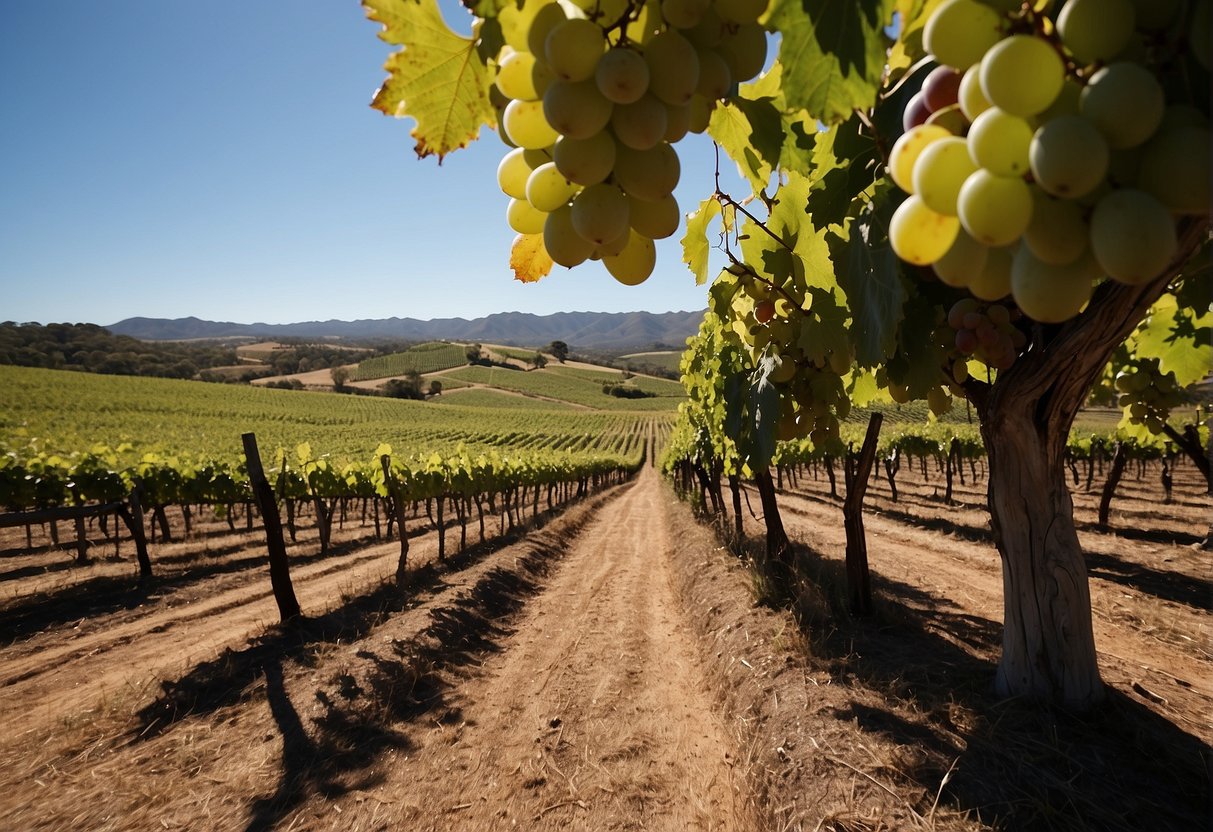
In Australia, winemaking is both an art and a science, one that you’re a part of every time you enjoy a glass of Australian wine. Your exploration of wines might take you to the lush vineyards that are scattered across various climates and landscapes, each producing unique grape varieties.
Most active wineries welcome you with open arms, especially during the harvest season which typically spans from February to April. This is when the grapes are at their peak for creating the wines you love. Winemakers are busy, but excited by the frenzy of activity that ensures the fruits are picked at the ideal time.
| Common Grape Varieties |
|---|
| Shiraz |
| Cabernet Sauvignon |
| Chardonnay |
| Merlot |
| Pinot Noir |
Among these areas, South Australia and New South Wales are celebrated for their warm climate varieties such as Shiraz and Cabernet Sauvignon. Meanwhile, Victoria cherishes the cool climate necessary for the perfect Pinot Noir. Each of these regions puts a part of itself into every bottle.
You’ll find that each winery offers a story—a blend of tradition, technique, and terroir. Sixth-generation growers may share anecdotes of the world’s oldest vines, while the wine itself tells you of the rolling hills and valleys where it’s been nurtured.
Understanding Wine Labels and Classifications
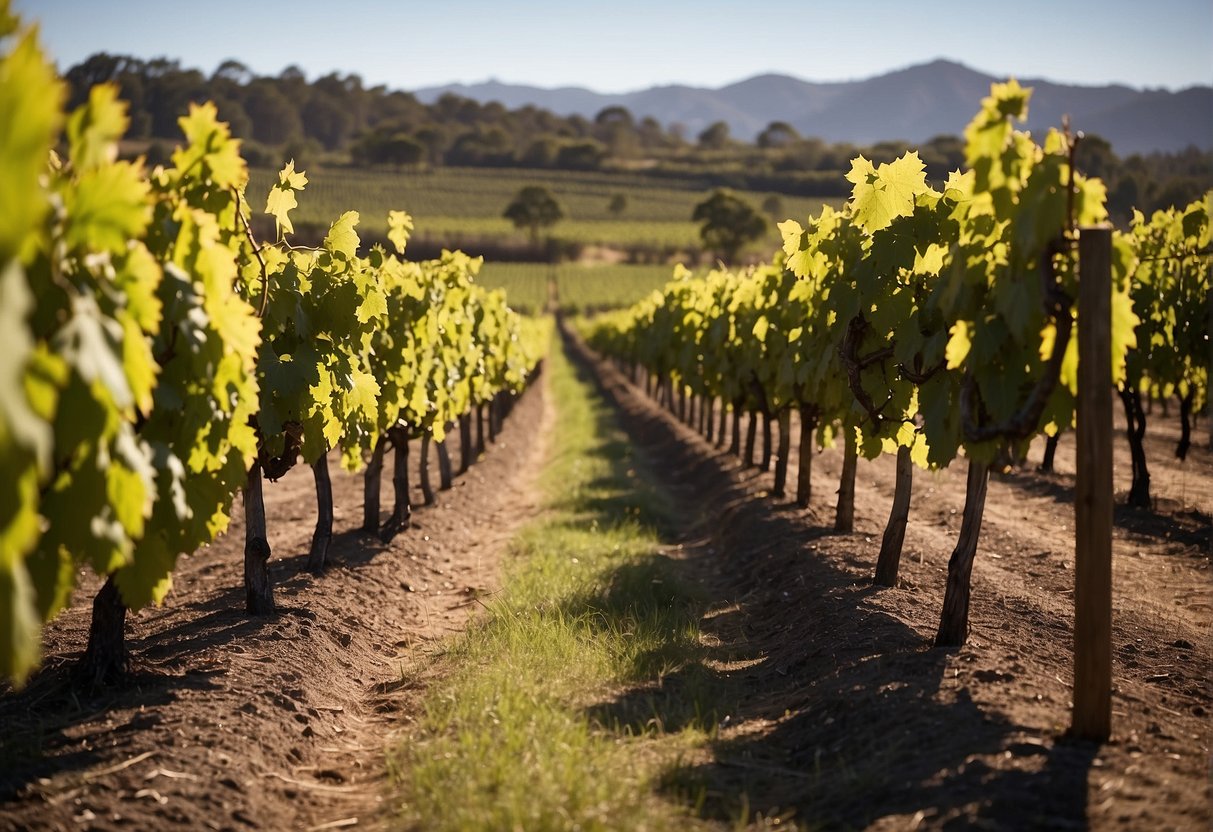
When you pick up a bottle of Australian wine, the label is your guide to its classification and origin. Labels in Australia must adhere to certain standards, which help you, as a consumer, understand the product’s quality and background.
Australian wine labels are governed by the system of Geographical Indications (GIs), a classification that defines the wine’s provenance. It’s akin to the French Appellation system. This involves categorization into super zones, zones, regions, and subregions, ensuring that each bottle reflects the unique characteristics of its origin.
Here’s a basic breakdown of the label components:
- Producer Name: Usually prominent, indicating who made the wine.
- Varietal: The type of grape used (e.g., Shiraz, Chardonnay).
- Region: Where the grapes were grown, tied to GIs, providing a clue to the wine’s style and quality.
| Label Term | What it Means |
|---|---|
| Estate Bottled | Wine is grown and produced on-site |
| Vintage Year | Harvest year of the grapes |
| GI Indication | Specific region of grape cultivation |
Moreover, labels feature allergen warnings if applicable, ensuring you’re informed about the contents.
In terms of classification, wines are often labeled with terms like “reserve” or “premium”. While these don’t have a legal standard, they often imply a higher quality or a winery’s confidence in the product.
Understanding these label components and classifications enhances your knowledge and appreciation of Australian wines. This insight ensures you find a wine that suits your taste and expectations.
For a deeper understanding of specific Australian GIs, explore the comprehensive overview provided by Wine Australia.
Wine Tourism in Australia
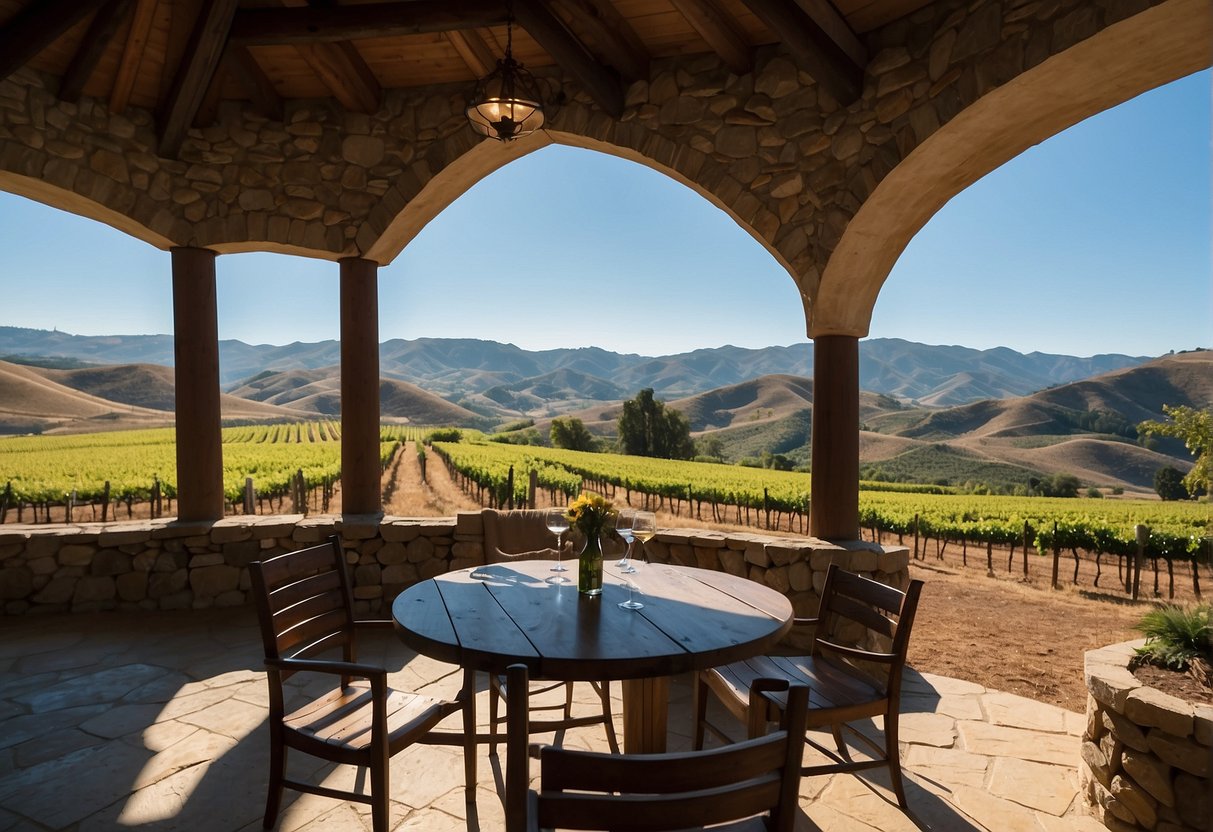
Wine tourism in Australia offers you a unique blend of natural beauty and leisurely pursuits paired with world-class wines and exquisite food. As you explore the wine country, you’ll find a variety of regions each offering their own distinct flavors and experiences.
Margaret River Wine Region – Noted for its coastal scenery and complex cabernet sauvignons, your visit here can be as leisurely as you desire. Picture yourself enjoying a lunch on a winery balcony overlooking the vine-striped hills.
- Highlights: Coastal views, complex reds
- Activities: Wine tasting, food pairing
Barossa Valley – Renowned for its bold shirazes and rich heritage, Barossa Valley invites you to indulge in a harmony of fine wines and local delicacies.
- Highlights: Bold shirazes, heritage
- Activities: Cellar tours, gourmet dining
McLaren Vale – A stone’s throw from the sea, you’ll experience a Mediterranean vibe with innovative wines and regional produce to tantalize your taste buds.
- Highlights: Innovative wines, regional produce
- Activities: Wine trails, beach visits
Clare Valley – This is your go-to for crisp, refreshing rieslings. Set amid rolling hills, you can sip your way through the valley at a leisurely pace.
- Highlights: Crisp rieslings, rolling hills
- Activities: Cycling wine trails, scenic picnics
Hunter Valley – As a premier wine destination near Sydney, enjoy the serenity of its vineyards and explore the blend of tradition and innovation in every glass.
- Highlights: Tradition, serenity
- Activities: Hot air balloon rides, vineyard concerts
With each visit, whether you’re taking a nature hike between tastings or settling in for a food and wine pairing, you’ll find that Australia’s wine regions offer an unforgettable sensory experience.
Pairing Food with Australian Wines
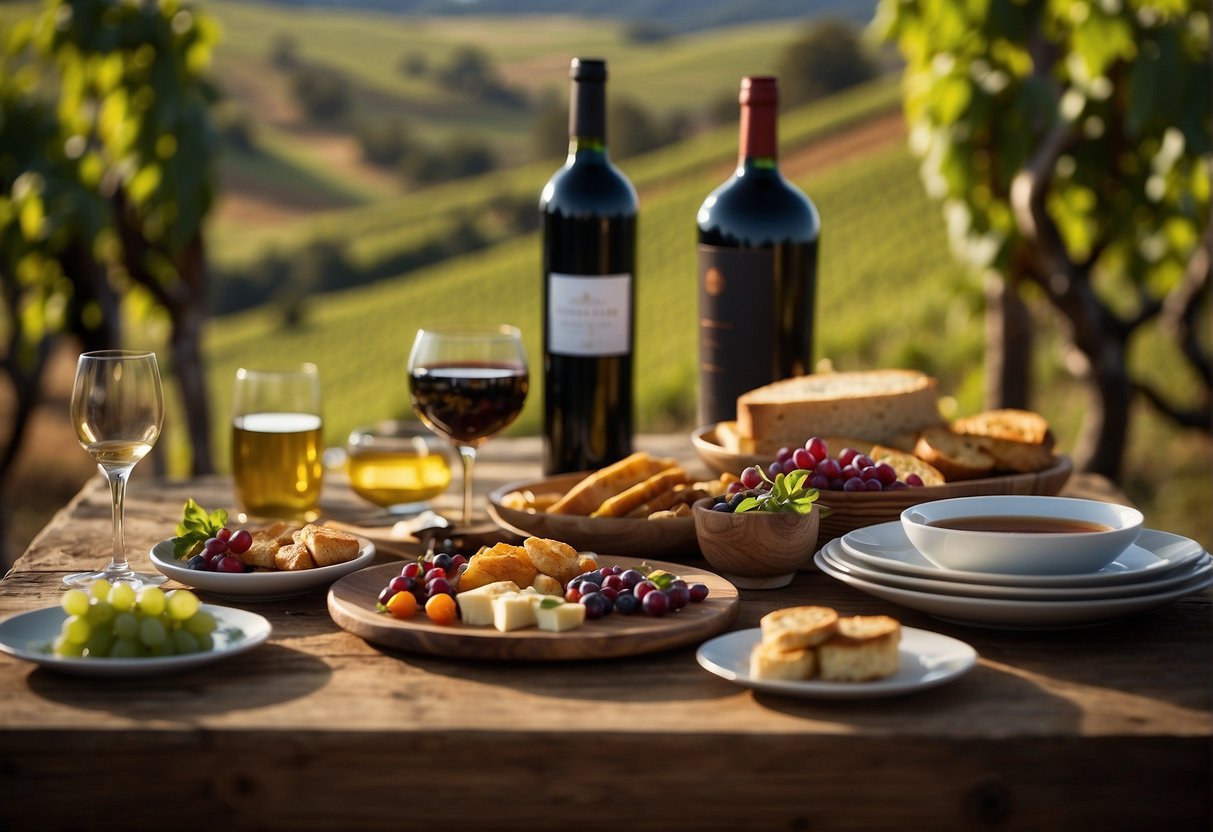
When you’re exploring the varied wine regions of Australia, each glass you enjoy can be enhanced by pairing it with the right food. This harmony between the plate and the pour is a gateway to experiencing the essence of both land and sea.
Start your lunch with a light dish and a crisp white wine:
- Seafood: Enjoy your prawns or oysters with a Sauvignon Blanc or Semillon for a refreshing taste that echoes the sea.
For a creamy or ginger-infused pumpkin soup, which is uniquely Australian, a fuller-bodied white like Chardonnay pairs wonderfully, bringing richness and balance to your meal.
Moving onto heartier dishes from the land:
- Beef and Lamb: A robust Shiraz, known for its bold dark fruit and spicy notes, complements the rich flavors of red meats impeccably.
- Tomato-based pastas or barbecued dishes: Opt for a bold Cabernet Sauvignon to stand up to these intense flavors.
Here’s a quick reference to help you match your meals with Australian wines:
| Food Type | Wine Recommendation |
|---|---|
| Light Seafood | Sauvignon Blanc |
| Creamy Soups | Chardonnay |
| Beef and Lamb Dishes | Shiraz |
| Heartier Pastas | Cabernet Sauvignon |
Environmental Impact and Sustainability
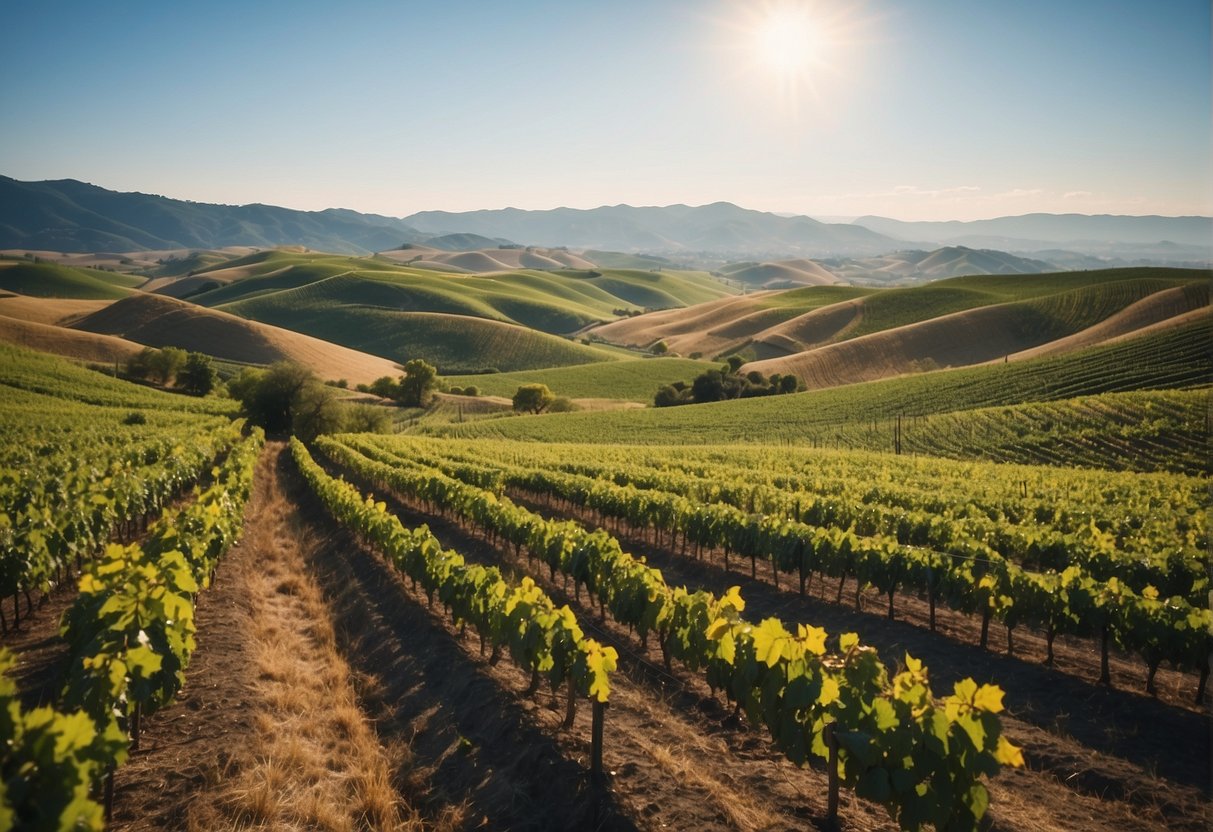
When you explore the wine regions of Australia, you’re immersing yourself in a tapestry where the land, sea, and nature intertwine closely with viticulture.
Australian winemakers are increasingly aware of their environmental footprint and are pioneering sustainable practices to ensure the health of their farms and respect for the ecosystem.
Sustainable wine production in Australia involves:
- Conserving natural resources:
- Water management techniques, such as rainwater harvesting and efficient irrigation, are critical. This not only preserves precious water reserves but also protects the marine life by reducing runoff into rivers and seas.
- Promoting biodiversity:
- By maintaining natural vegetation and wildlife, wineries contribute to a balanced ecosystem. This approach also includes using beneficial insects for pest control instead of relying solely on chemicals.
Soil management is at the heart of sustainability, with techniques like cover cropping to prevent erosion.
Your visit to these wine regions might reveal a vibrant cover of greenery between vine rows, showcasing how the industry safeguards the land.
Australian wineries are taking the initiative to reduce their carbon footprint by adopting renewable energy and reducing greenhouse gas emissions.
This is a forward-thinking approach in response to climate challenges that can affect grape quality and yield.
Energy-efficient winery designs and use of lightweight bottles are examples of how the wine sector is constantly evolving, with a keen eye on sustainability.
Through these initiatives, Australian wineries demonstrate their commitment to environmental stewardship and ensure you can enjoy their wines, knowing that respect for nature is at the core of their operations.
For more details on the extensive research on climate projections for Australia’s wine regions, you might find the work by the University of Tasmania interesting and insightful.
Additionally, the various sustainable practices adopted by wineries are well-summarized on the Wine Australia sustainability page.
Culture and Community
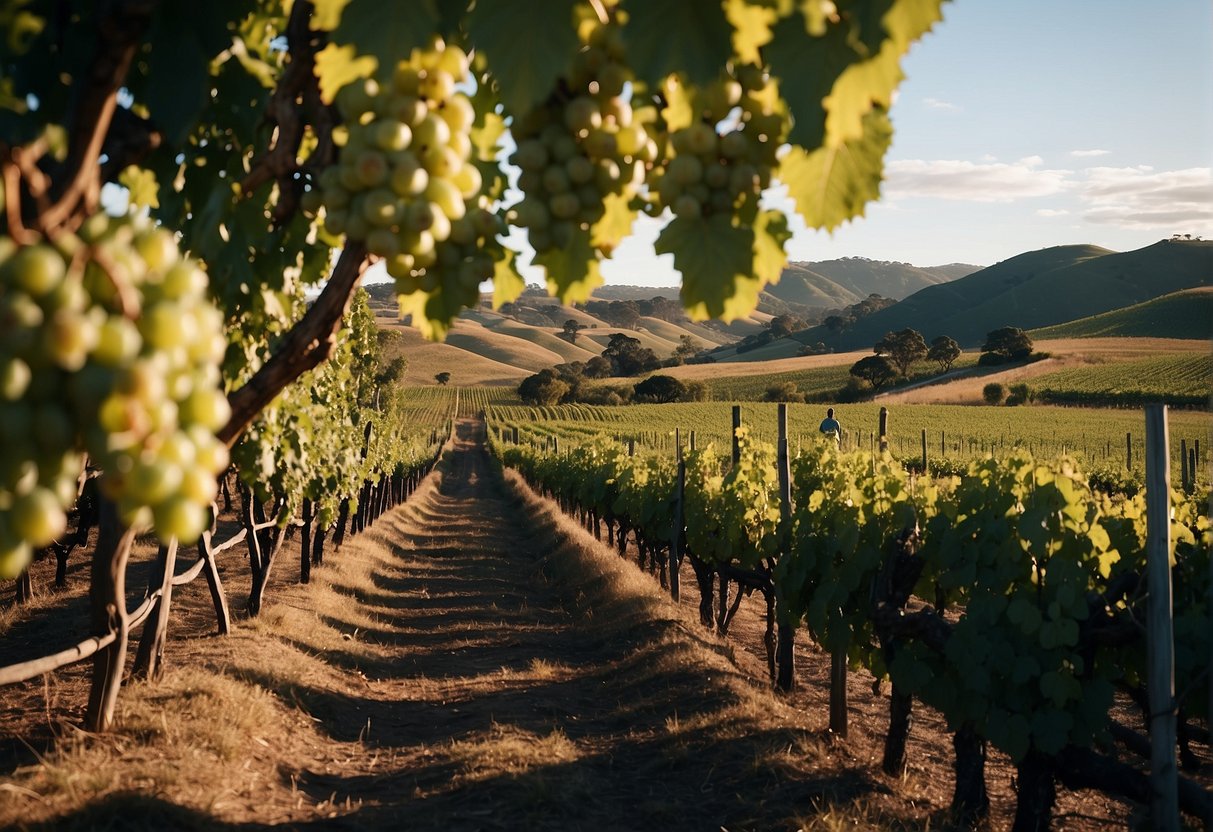
In the heart of Australia’s wine territories, you’ll often find a vibrant community tied together by more than love for viticulture.
Wineries are not just production sites; they are centrepieces for cultural expression and gatherings where traditions blend with innovative wine-making practices.
Consider the Macedon Ranges, nestled just north of Melbourne. Beyond being the coolest mainland wine growing region, it also offers a unique local community vibe.
Immerse yourself in events where winemakers eagerly share their crafts and connect with patrons over a shared passion for fine wines amidst dramatic landscapes.
- Cultural Significance
- Aboriginal influence: Integrate indigenous practices.
- Celebrations: Harvest festivals, wine tastings.
In these regions, Aboriginal and Torres Strait Islander cultures are often interwoven into the wine-making process, bringing an ancient perspective to an age-old craft.
You’re not just sipping wine; you’re experiencing a tapestry of stories and customs that span thousands of years.
Local festivals celebrate the seasonal cycles of harvesting and tap into the communal joy of wine production.
Expect your tastes to be paired with local produce, music, and artworks that reflect the region’s identity.
Your visit not only supports local wineries but also contributes to the sustenance of these cultural communities.
You’ll find that in Australia, wine is more than a beverage; it’s a bridge between the past and present, inviting you to be a part of it all.
Enjoy every glass with the awareness that you’re partaking in a community’s heart and soul, flavored not just by the terroir, but by its people.
The Future of Australian Wine
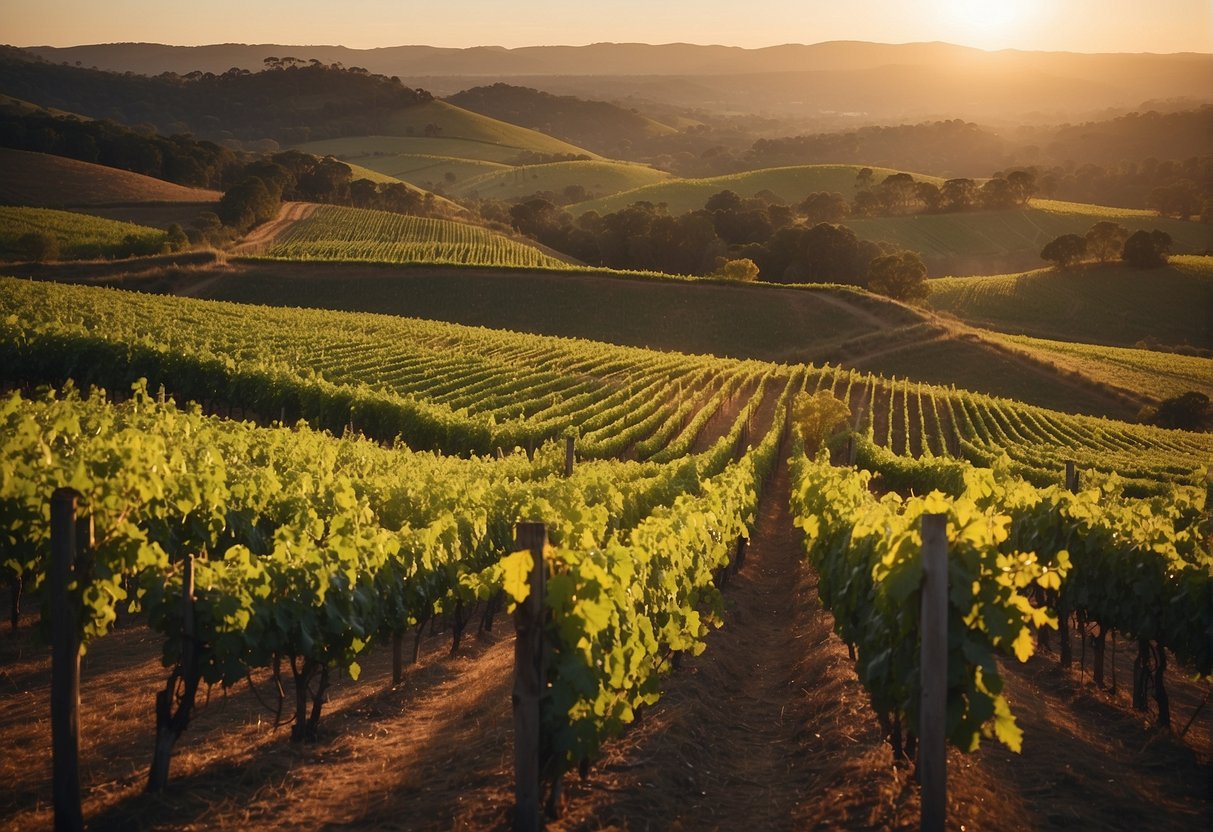
The landscape of Australian wine is evolving. You may know Australia for its iconic Sydney Harbour or the rugged Outback, but its wine regions are equally renowned and facing a dynamic future.
Due to climate change, wine producers are learning to adapt, ensuring you can enjoy your favorite Aussie wine for years to come.
You’ll find that efforts to map Australia’s Wine Future have led to innovative research, such as the Climate Atlas.
This resource helps vineyards in Australia navigate through changes by providing data specific to viticulture.
It’s like having a GPS for grape growing, guiding winemakers through the complexities of weather patterns.
Key Australian Wine Regions and Adaptation Strategies:
- Margaret River:
- Anticipating wetter winters and hotter summers, vignerons are exploring new grape varieties.
- Barossa Valley:
- Known for bold Shiraz, it is adapting to heat with different canopy management techniques.
- Yarra Valley:
- With the potential for more extreme weather, wineries are investing in water-saving technologies.
Your continued enjoyment of fine Australian wine hinges on such significant adaptations.
As an aficionado or casual sipper, you can taste the resilience in every glass.
Whether it’s a crisp Riesling from Clare Valley or an elegant Pinot Noir from Tasmania, rest assured that the heart of Australia’s wine country beats strong in the face of change.
Frequently Asked Questions
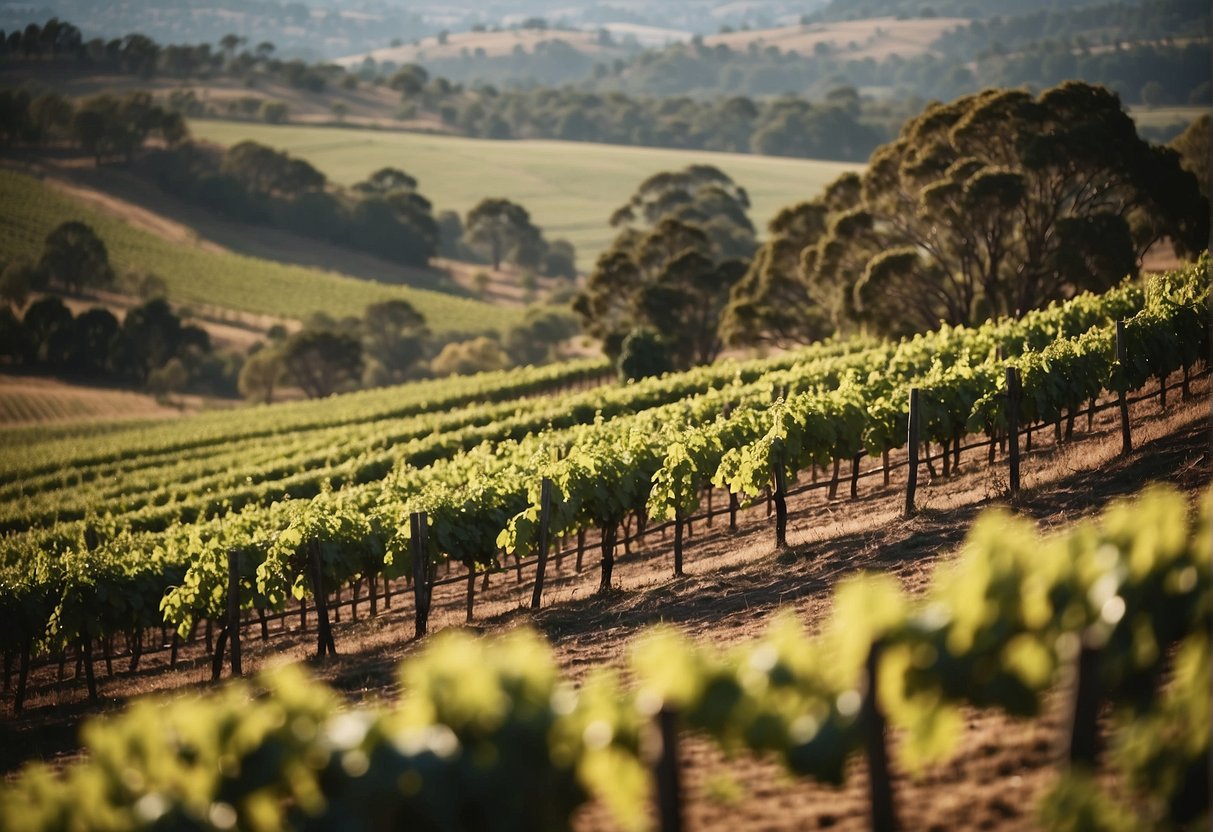
In this section, you’ll find answers to some of the most common questions about Australia’s diverse wine regions, ensuring you can explore the viticultural landscape with confidence.
Which area is considered the main wine region in Australia?
The Barossa Valley in South Australia is often considered the flagship wine region of Australia, renowned for its world-class Shiraz.
What are the most renowned wine regions in South Australia?
South Australia is home to several prestigious wine regions, including the Barossa Valley, Clare Valley, McLaren Vale, and the Coonawarra.
How many distinct wine regions does Australia boast?
Australia boasts over 65 wine regions, each offering unique wines and grape varieties.
What are the top wine regions to visit in Australia for a memorable experience?
For a memorable wine-tasting experience, you should consider visiting the Margaret River Wine Region, Barossa Valley, McLaren Vale, Clare Valley, and Yarra Valley.
From which five Australian states does the majority of the country’s wine originate?
The majority of Australia’s wine comes from South Australia, Victoria, New South Wales, Western Australia, and Tasmania.
What variety of wine is most synonymous with Australia’s wine industry?
Shiraz is the most synonymous wine variety with Australia’s wine industry. It represents a significant portion of the country’s wine production.
